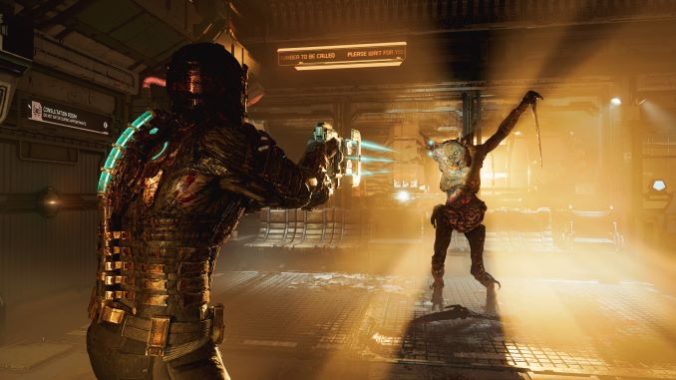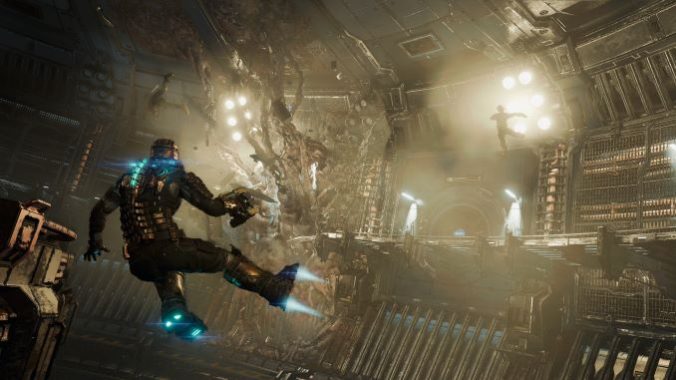The Dead Space Remake Strategically Dismembers the Original

It’s easy to be poetic about Dead Space. Though the game is a clear hodge podge of influences-Event Horizon, Alien, and Resident Evil 4 at the forefront—the sci-fi horror classic manages a breathless evocation that is hard to pinpoint, but decidedly more than the sum of its parts. Its imposing industry and claustrophobic hallways twist through shifting light, hiding unknownable metal and flesh. In its best moments, playing Dead Space feels like wandering through a massive body, determined to break you down and devour you.
Though much has changed since Dead Space released in 2008, the tools of terror haven’t really. This year’s ground-up remake reimagines or reworks plenty about the original, but constantly postures at devotion. The general thrust of the art direction is largely the same. The remake’s biggest changes are in narrative details. Most of the more technical changes might remain unnoticed if you haven’t played the original recently. The Dead Space remake is not as thorough a reimagining as Final Fantasy VII Remake, but it’s closer to that than one might think.
In some sense, both versions of Dead Space occupy highs and lows. The game’s corny and relentless use of graffiti is still present, for example. Seeing “CUT OFF THEIR LIMBS” written in blood above the game’s first weapon is as clumsy and ill-fitting as it was originally. In contrast, the game’s inobtrusive AI is as enveloping as ever. Forcing a constant gaze at Isaac’s cowering body underscores the skeleton of his armor, reinforcing the ways his body appears like those he fights. It makes checking for health and ammo counts easy and undistracting.
The sound design too is oft-praised, even influential as noted in this retrospective from Lewis Gordan, and its virtues are still present here. Every space sequence in Dead Space is bracing and thrilling. Sound is muffled, but almost absent and it makes enemies harder to track and violence disturbing in its intimate quiet. One of my favorite details is the constant whispering, which sometimes sounds like it’s coming over the announcement speakers, and sometimes seems like it’s a voice from nowhere—a distant prayer broadcast over an unfamiliar signal. These voices are quiet, but still plaintive and desperate. It’s the hush that covers over you in a graveyard, the sense of unfamiliar mourning. Nevertheless, I was driven to uncontrollable laughter when a voice whispered “self-inflicted ocular injury” with the tone of an IMDB parent’s guide.
The necromorphs themselves are perhaps the most dramatic example of these peaks and valleys. Every enemy in Dead Space is effectively a space zombie, a mass of re-arranged parasitic flesh. The game’s baseline of horror is based on a “normal” body twisted beyond recognition. But they are just kinda goofy, aren’t they? The necro-babies in particular, obviously the product of a (sometimes) toothless edginess, are some of the silliest enemies in horror games. Furthermore, the game treats every appearance of every necromorph as the height of terror. It can feel ridiculous when a massive music sting hits for a single enemy that you will dispatch in two shots.
However, Dead Space, both in memory and in this recent reincarnation, is quite good at keeping you on your toes. The constant music stings sometimes feel cheap, but they also act as a fog over what will happen next. When music mounts, Isaac is under threat, but what kind of threat and where it will emerge from is still unknown. Different necromorphs must be dispatched differently, and groups of varied enemies can offer a devilish challenge. While there are some battles that will end with frightful ease, just as many are flailing and desperate. Even on “medium” difficulty my wits and nerves were sometimes tested.

-

-

-

-

-

-

-

-

-

-

-

-

-

-

-

-

-

-

-

-

-

-

-

-

-

-

-

-

-

-

-

-

-

-

-

-

-

-

-

-








































